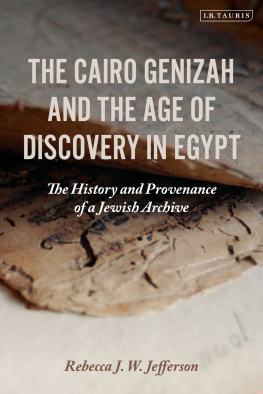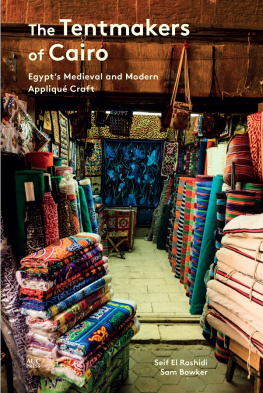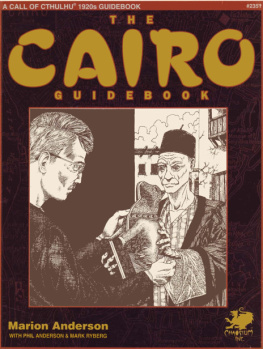This electronic edition published in 2021 by
The American University in Cairo Press
113 Sharia Kasr el Aini, Cairo, Egypt
One Rockefeller Plaza, 10th Floor, New York, NY 10020
www.aucpress.com
Copyright 2021 by Annalise J.K. DeVries
All rights reserved. No part of this publication may be reproduced, stored in a retrieval system, or transmitted in any form or by any means, electronic, mechanical, photocopying, recording, or otherwise, without the prior written permission of the publisher.
ISBN 978 977 416 978 6
eISBN 978 1 649 03041 2
Version 1
ACKNOWLEDGMENTS
W hen I arrived in Cairo to begin research on this project in the autumn of 2009, I was not sure what kind of materials I would find, and I prepared myself for an arduous process of applying to archives while also combing through newspapers and tracking down oral histories. While several of those avenues proved promising, my real research breakthrough came the following year, after longtime Maadi resident Samir Raafat donated a large portion of his materials on the history of the area to the Rare Books and Special Collections Library at the American University in Cairo. Mr. Raafats book, Maadi , 19041962 : Society and History in a Cairo Suburb , was the first history of Maadi, and while we never had the opportunity to meet in person, his work offered the foundation for my own and I remain greatly indebted to him. I am additionally grateful to Stephen Urgola, the university archivist at AUC, and his staff, who assisted me throughout the research process, identifying resources from Mr. Raafats collection and locating additional materials that further aided my efforts.
This project additionally owes a great deal to Maadis environmental activists, whom I was introduced to by Sallie Kishk. I am grateful to Nadia Salem, Maggie Safwat, Ingy Safwat, Samia Zeitoun, Maggie Zaki, and Adl Nimatallah, who were all especially gracious as they shared their recollections of their home with me.
My research came during a revolutionary period in Egypts history. The events of 25 January 2011 and their aftermath necessitated that I leave the country, and I heard the news of Hosni Mubaraks downfall from England, where I continued my research for several months as conditions in Egypt remained unstable. I found an especially welcoming environment at Oxford University, where the Middle East Centre Archive at St. Antonys College provided ample materials. The centres archivist, Debbie Usher, offered invaluable assistance as I continued my work. In England I also had the opportunity to conduct oral history interviews with some of Maadis former residents, and I thank Gabriel Josipovici and his cousin Anna Joannides for allowing me into their homes and for sharing their memories with me.
Also in Cairo, I remain grateful to Paul-Gordon Chandler, who provided valuable resources on the history of the Church of St. John. Amy Widener was not only my first friend in Maadi, but also paved the way for my first research breakthrough when she put me in touch with the gardening enthusiasts of the Maadi Womens Guild. This project would not have been possible without the ongoing kindness of Mike and Marty Reimer, whose Digla flat became home to me. I remain grateful to them for their ongoing support and to Mike for chances to continue collaborating.
Craig Encer and his Levantine Heritage Foundation introduced me to the many nuances and ongoing legacy of eastern Mediterranean life. Through his work, I was introduced to Alithea Lockie, whom I thank for offering additional details on the Williamson family and for allowing me to include some of her family photos here. I am additionally grateful to Nona Orbach and her recollections of her grandfather Isaac Kipnis, as well as the photos she shared with me.
This project received support from the US Fulbright Scholarship to Egypt, as well as predissertation small grants through the Mellon Foundation and the Graduate School-New Brunswick at Rutgers University. I am especially grateful for the mind-sharpening instruction I gleaned from the history faculty at Rutgers University. Seth Koven offered sustained assistance throughout my processes of research and writing, as well as great personal kindness when I evacuated Cairo. Bonnie Smith, Toby Jones, and David Cannadine opened up my eyes to the various facets of global history, Mediterranean trade networks, and the complexity of class relations in the Middle East. They each helped me refine my thinking and focus my analysis as I put my ideas into writing. Al Howard offered the kind of friendly, consistent, and patient support that I hope to emulate in my own career. Special thanks to Nova Robinson and her ongoing friendship and collaborative spirit. Any success I enjoyed at Rutgers and since would also not have been possible without the ongoing comradery of Elizabeth and Zach Churchich, Kat Mahaney, and Alex Gomez-del-Moral. Thanks, also, to Carol Helstosky, whose early mentorship paved the way for many of my professional achievements.
While writing my dissertation from Birmingham, Alabama, I also benefitted from the rich academic communities at Birmingham-Southern College, the University of Alabama, and my current academic home at Samford University. I am especially grateful to Jonathan Bass for his mentorship and to Jason Wallace for sharpening my thinking. I am additionally thankful for the friendship of Michelle Little, whose passion for oral histories has helped confirm my own conviction that local histories allow little places to tell big and important stories.
Special thanks go to Nadia Naqib at the American University in Cairo Press for believing in and supporting this project from our earliest conversations. I am grateful for reviewer comments, especially those for the full manuscript, which were instrumental in refining my thinking and keeping my analysis on track. Thank you also to AElfwine Mischler for her thoughtful notes and careful editing as it drew to a close. Part of my research on Maadis environmentalists was previously included in an article in the Journal of Social History and I am grateful for permission to include that material here.
My own personal story ultimately became a small part of Maadis ongoing history. I would not have known the town existed had my Aunt Tina, Uncle Sam, and cousins Micah and Mark not moved there in the early 1990s. My extended family bears the imprint of Maadis international legacy with three marriages and four grandchildren (and counting) who all come from matches made south of Cairo. My parents and siblings Matt, Jessica, and Joel have been the stable base of my support network. I am ever grateful for my dads charge since childhood to pursue my dreams, and my moms constant faith that such achievements are possible. I am also grateful to my grandmothers, whose legacies of education, hard work, a love of history, and insatiable curiosity planted the seeds for my career from my earliest years.
My life today is another instance of the global ties that formed in Maadi. Like so many residents before me, I met and eventually married another global traveler after our paths briefly crossed in this small suburban space. Because our story began in Maadi, it seems only fitting that I dedicate the following to my companion on lifes adventures, Stephen DeVries.








